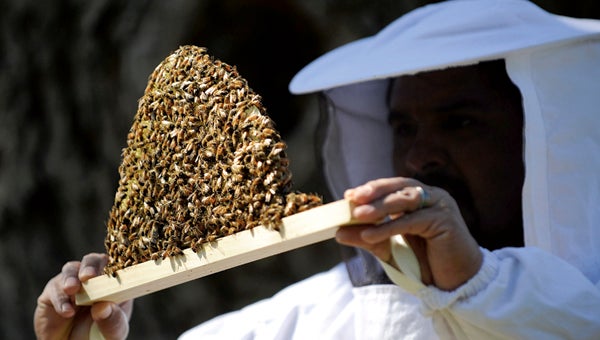Notes from a Beekeeper: Please don’t kill the honeybees
Published 7:11 pm Saturday, March 8, 2014
By Tom Garcia, Washington beekeeper
The first day of spring is just a few short weeks away. I think most of us will be happy to say goodbye to winter. I know I certainly am looking forward to some nice heat — I even welcome the humidity.
As the trees and flowers begin to bloom, beekeepers everywhere are preparing for the season. For those of you who are not beekeepers, I ask for your help. Please don’t kill the honeybees.
Like nearly everything else during this time of year, honeybees are getting ready to do their thing. The population of each colony is starting to build and will increase rapidly as the weather warms. That means that these colonies will also begin casting swarms.
Swarms are the natural way that honeybees divide themselves and propagate. I describe swarms as absolutely beautiful and fascinating, though losing swarms is not good for the beekeeper. However, it is nature’s way of multiplying. For those of you who may witness your first swarm this year, I admit that it can be a little frightening seeing a ball of 10,000 honeybees hanging onto a tree limb, your mailbox or on just about anything else.
While honeybees in this state may appear frightening, they are in fact at their most docile during a swarming event. When you see them perched on something, they may be there for an hour or for a couple of days. They are simply in a temporary location while the scouts go out and find a new home. Once a scout returns with news of a location with an acceptable place to call home, they will take flight and disappear in about 15 minutes. They will be gone and your will never know they were there.
Of course, when 10,000 (or more) honeybees take flight all at once destined for a new home, the sight and sound of a buzzing vortex of honeybees is incredibly awesome. Again, they are in a docile state and do not have a tendency to sting, as long as they are not bothered.
This is where I ask for your help. I think many people, when faced with a swarm of honeybees, are quick to look for the can of Raid or some other insect killer, sneak up to the ball of honeybees and spray the heck out of them — and then run for cover. This is pretty much the worst thing anyone can do.
First, killing the honeybees is bad for the honeybees and for all of us, as we depend on them for pollination that generates much of the food we eat. Second, attempting to kill honeybees in this manner is dangerous, and you will likely get stung several times before you reach cover.
It is no secret that honeybees are important to our environment and us. It is also no secret that the bee population, both feral and managed, is suffering severe declines—approximately 30 percent every year for the last several decades. I ask the local community to be bee-friendly and consider a few alternatives before reaching for a can of poison to remove unwanted honeybees.
Bee-friendly actions:
Contact a beekeeper — If you have a swarm of honeybees or a colony you would like removed contact a beekeeper or your local beekeeping club. They may be able to provide the honeybees a new home. You can contact the Bee Patrol at several numbers: Chris, 252-365-0884; Tom, 801-706-7527; or Mike, 252-402-7711. Contact one of us and we will be happy to come out and see what we can do.
Contact Animal Control — Animal control likely has a beekeeper on their call list. Someone will arrive who can give the honeybees a place to live.
Do nothing — A swarm of honeybees is in search of a new home and will only be present for a few hours in most cases. However, they may linger for a day or two. The honeybees will leave as soon as their scouts have found new accommodations for the colony. The honeybees will depart en masse and vanish in a few minutes. It is amazing to witness their departure.
Become a beekeeper — If you have ever wondered about beekeeping, join your local beekeepers club to learn more. As a beekeeper, you can give swarming honeybees a good home, help the environment, educate others and harvest some delicious honey.
You can find more information on our website, including pictures to help you identify a bee swarm. Look under the “Bee Removal” section. The link to our website is below.
Each of us has a role in helping to sustain our environment. The next time you have unwanted honeybees, try some of these options. These little critters are pretty darn important, and they could use our help. Thank you.
Please visit the Beaufort County Beekeepers website for to learn more about honeybees and beekeeping: https://sites.google.com/site/beaufortcountybeekeepers.






